The cercal organ may provide singing tettigoniids a backup sensory system for the detection of eavesdropping bats
- PMID: 20856887
- PMCID: PMC2938355
- DOI: 10.1371/journal.pone.0012698
The cercal organ may provide singing tettigoniids a backup sensory system for the detection of eavesdropping bats
Abstract
Conspicuous signals, such as the calling songs of tettigoniids, are intended to attract mates but may also unintentionally attract predators. Among them bats that listen to prey-generated sounds constitute a predation pressure for many acoustically communicating insects as well as frogs. As an adaptation to protect against bat predation many insect species evolved auditory sensitivity to bat-emitted echolocation signals. Recently, the European mouse-eared bat species Myotis myotis and M. blythii oxygnathus were found to eavesdrop on calling songs of the tettigoniid Tettigonia cantans. These gleaning bats emit rather faint echolocation signals when approaching prey and singing insects may have difficulty detecting acoustic predator-related signals. The aim of this study was to determine (1) if loud self-generated sound produced by European tettigoniids impairs the detection of pulsed ultrasound and (2) if wind-sensors on the cercal organ function as a sensory backup system for bat detection in tettigoniids. We addressed these questions by combining a behavioral approach to study the response of two European tettigoniid species to pulsed ultrasound, together with an electrophysiological approach to record the activity of wind-sensitive interneurons during real attacks of the European mouse-eared bat species Myotis myotis. Results showed that singing T. cantans males did not respond to sequences of ultrasound pulses, whereas singing T. viridissima did respond with predominantly brief song pauses when ultrasound pulses fell into silent intervals or were coincident with the production of soft hemi-syllables. This result, however, strongly depended on ambient temperature with a lower probability for song interruption observable at 21°C compared to 28°C. Using extracellular recordings, dorsal giant interneurons of tettigoniids were shown to fire regular bursts in response to attacking bats. Between the first response of wind-sensitive interneurons and contact, a mean time lag of 860 ms was found. This time interval corresponds to a bat-to-prey distance of ca. 72 cm. This result demonstrates the efficiency of the cercal system of tettigoniids in detecting attacking bats and suggests this sensory system to be particularly valuable for singing insects that are targeted by eavesdropping bats.
Conflict of interest statement
Figures
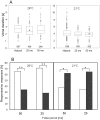
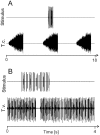
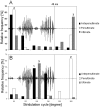
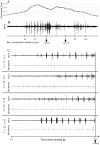
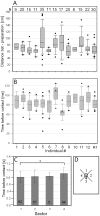
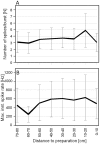
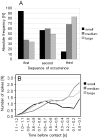

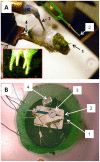
Similar articles
-
Echolocation and passive listening by foraging mouse-eared bats Myotis myotis and M. blythii.J Exp Biol. 2007 Jan;210(Pt 1):166-76. doi: 10.1242/jeb.02644. J Exp Biol. 2007. PMID: 17170159
-
Listening for bats: the hearing range of the bushcricket Phaneroptera falcata for bat echolocation calls measured in the field.Proc Biol Sci. 2000 Sep 7;267(1454):1711-5. doi: 10.1098/rspb.2000.1199. Proc Biol Sci. 2000. PMID: 12233766 Free PMC article.
-
Sensory ecology of predator-prey interactions: responses of the AN2 interneuron in the field cricket, Teleogryllus oceanicus to the echolocation calls of sympatric bats.J Comp Physiol A Neuroethol Sens Neural Behav Physiol. 2005 Jul;191(7):605-18. doi: 10.1007/s00359-005-0610-3. Epub 2005 May 11. J Comp Physiol A Neuroethol Sens Neural Behav Physiol. 2005. PMID: 15886992
-
Adaptations for Substrate Gleaning in Bats: The Pallid Bat as a Case Study.Brain Behav Evol. 2018;91(2):97-108. doi: 10.1159/000488873. Epub 2018 Jun 6. Brain Behav Evol. 2018. PMID: 29874652 Review.
-
Evolutionary escalation: the bat-moth arms race.J Exp Biol. 2016 Jun 1;219(Pt 11):1589-602. doi: 10.1242/jeb.086686. J Exp Biol. 2016. PMID: 27252453 Review.
Cited by
-
Sheep in wolves' clothing: prey rely on proactive defences when predator and non-predator cues are similar.Proc Biol Sci. 2020 Aug 26;287(1933):20201212. doi: 10.1098/rspb.2020.1212. Epub 2020 Aug 26. Proc Biol Sci. 2020. PMID: 32842929 Free PMC article.
-
Corollary discharge inhibition of wind-sensitive cercal giant interneurons in the singing field cricket.J Neurophysiol. 2015 Jan 1;113(1):390-9. doi: 10.1152/jn.00520.2014. Epub 2014 Oct 15. J Neurophysiol. 2015. PMID: 25318763 Free PMC article.
-
Revisiting adaptations of neotropical katydids (Orthoptera: Tettigoniidae) to gleaning bat predation.Neotrop Biodivers. 2017 Jan 1;3(1):41-49. doi: 10.1080/23766808.2016.1272314. Epub 2017 Jan 24. Neotrop Biodivers. 2017. PMID: 28261664 Free PMC article.
-
Sensory-based niche partitioning in a multiple predator - multiple prey community.Proc Biol Sci. 2015 Jun 7;282(1808):20150520. doi: 10.1098/rspb.2015.0520. Proc Biol Sci. 2015. PMID: 25994677 Free PMC article.
-
The foraging ecology of the mountain long-eared bat Plecotus macrobullaris revealed with DNA mini-barcodes.PLoS One. 2012;7(4):e35692. doi: 10.1371/journal.pone.0035692. Epub 2012 Apr 24. PLoS One. 2012. PMID: 22545129 Free PMC article.
References
-
- Hoy RR. The evolution of hearing in insects as an adaptation to predation from bats. In: Webster DB, Fay RR, Popper AN, editors. The evolutionary biology of hearing. Berlin Heidelberg New York: Springer; 1992. pp. 115–129.
-
- Fullard JH, Yack JE. The evolutionary biology of insect hearing. Trends Ecol Evol. 1993;8:248–252. - PubMed
-
- Hoy RR, Robert D. Tympanal hearing in insects. Annu Rev Entomol. 1996;41:433–450. - PubMed
-
- Yager D. Structure, development, and evolution of insect auditory systems. Micros Res Techn. 1999;47:380–400. - PubMed
-
- Triblehorn JD, Yager DD. Wind generated by an attacking bat: anemometric measurements and detection by the praying mantis cercal system. J Exp Biol. 2006;209:1430–1440. - PubMed
Publication types
MeSH terms
Grants and funding
LinkOut - more resources
Full Text Sources
Molecular Biology Databases
Research Materials

